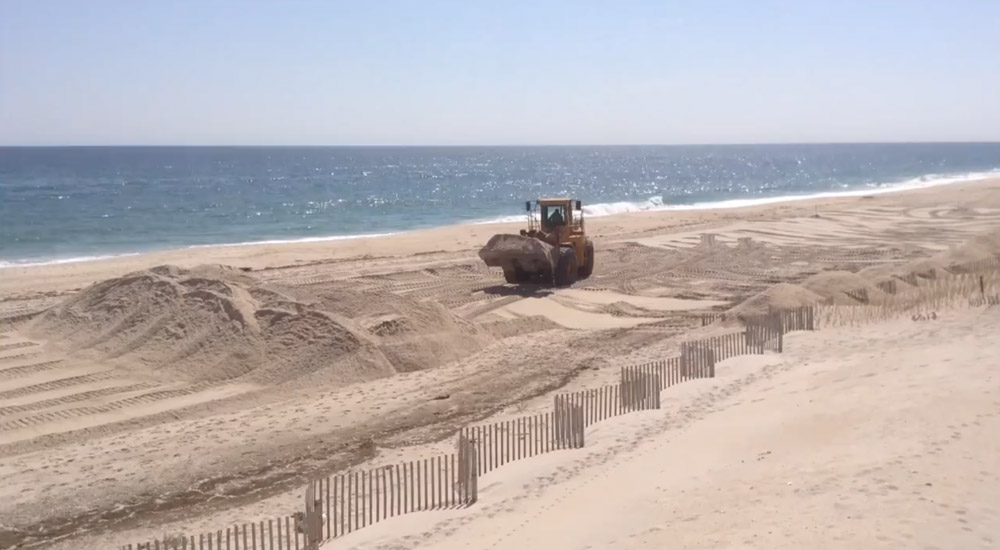Article posted with permission from ASBPA
After your beach was nourished, did you wonder where all that sand went? A new white paper has an easy answer: Right where it was designed to go.
The movement of large volumes of sand from newly nourished beaches is simply a process of “profile equilibration,” explains the white paper just published by the American Shore & Beach Preservation Association (ASBPA)’s Science & Technology Committee.
This natural adjustment moves sand placed in the upland or dry beach zone offshore into the nearshore waters, eventually creating the natural more gentle slope of the underwater beach using waves and currents to relocate sand where dump trucks and dredges cannot.
So all the sand didn’t wash away from your newly nourished beach. It went where it was designed to go.
Let’s start from the beginning: Beach nourishment places sand (usually brought in from offshore) along the dry portion of the beach, where it is shaped by bulldozers into what is called an initial construction fill profile. This constructed fill profile typically has two components:
- Design fill: The amount of sand necessary to meet the design goal… say, a certain number of feet of beach seaward of the dune to keep storm waves away from attacking the dune.
- Advanced fill: This amount of sand is based on the expected amount of erosion between the completion of this project to the start of the next one, a “sand reserve” to allow normal erosion without endangering the design fill beach.
During construction, the dredging contractor places sand on the dry beach at a slope steeper than the natural beach slope because it’s cost-prohibitive to build the beach the way nature wants it. After construction, the waves and currents redistribute the sand, moving it offshore to create a more stable beach shape. We call this movement “beach equilibration.”
During this process, no sand has been lost from the beach profile, it has just moved offshore to create a more natural underwater slope and sandbar which is an integral part of the beach system. With this slope waves break further offshore, helping to protect the dry beach and dunes.
Just because the engineers expect this process to occur doesn’t mean it’s still not a shock to first-time viewers of a nourished beach. After all, once the beach is in need of initial nourishment it’s usually in pretty sorry shape, sand-starved and narrow, often missing at high tide and certainly unable to provide any protective from storm waves.
Beachfront property owners and coastal communities may have just spent years to organize support for this initial nourishment, gone through an extensive process to find funding for a project, selected contractors to design and construct it, and waited patiently for permits.
They are rightly both proud and relieved to have this new high and wide beach in place, to protect their properties, provide habitat and enhance recreation. To see a significant portion of it disappear beneath the waves within months of construction can be very disheartening.
That was the impetus for the Science & Technology Committee to draft this white paper, to explain in lay terms why what people see happening is intended and good for their beach – not a sign of failure for the nourishment project. We also wanted to provide some good news, since the speed at which the shoreline initially appears to retreat after construction will slow down once the beach reaches its stable shape.
“With many communities financing expensive beach nourishment projects, it is more important than ever to communicate the physical response of an engineered beach,” said Nicole Elko, Ph.D., ASBPA’s vice president for science & technology and one of the paper’s author. “A basic understanding of the post-construction offshore transport process can bring great reassurance to a concerned coastal stakeholder.”
This paper is a continuation of ASBPA’s efforts to explain and highlight the beneficial role nourished beaches plan in so many coastal communities. Such efforts include:
- The newly released National Beach Nourishment Database, an ongoing effort which compiles data on projects comprised of nearly 1.5 billion cubic yards of sand placed in nearly 400 projects covering the continental U.S. coastline.
- The annual Best Restored Beaches awards, spotlighting successful beach restoration efforts around the nation. This year’s winners will be announced in late May.
The complete equilibration white paper is available online at: http://asbpa.org/wpv2/wp-content/uploads/2016/03/WhitePaper_85_2_Profile_Eq.pdf, and will be published in the next edition of “Shore & Beach,” ASBPA’s quarterly peer-reviewed journal. The National Beach Nourishment Database is online at: https://gim2.cbi.com/ASBPANationwideRenourishment/.
# # #
ABOUT ASBPA: Founded in 1926, the American Shore & Beach Preservation Association (ASBPA) is a 501(c)3 nonprofit that advocates for healthy coastlines by promoting the integration of science, policies and actions that maintain, protect and enhance the coasts of America. For more information on ASBPA, go to www.asbpa.org, Facebook or www.twitter.com/asbpa. For information, to change your email address or to unsubscribe from this list, contact us at managing@asbpa.org. A complete collection of Beach News Service articles is available for media access online at. http://asbpa.org/publications/american-beach-news-service/
NOTE: Beach profile graphics showing the equilibration process and fill types is available by contacting ASBPA at managing@asbpa.org.


